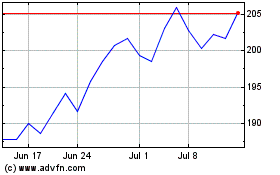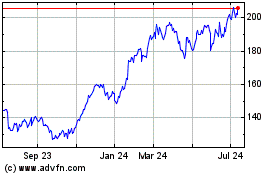SALESFORCE.COM
E-Commerce Service Based on Acquisition
Salesforce.com Inc. on Tuesday introduced a new e-commerce
service based on its $2.8 billion acquisition of Demandware Inc. in
July.
The Salesforce Commerce Cloud is intended to help customers set
up online storefronts and in-store tablets and kiosks, adding
commerce functions to the company's portfolio of software delivered
as a service over the internet.
Salesforce is best known for applications that help salespeople
track customer contacts and marketers plan campaigns.
The new service faces stiff competition from Oracle Corp., SAP
SE, and International Business Machines Corp., which have strong
digital commerce offerings, according to research firm Gartner
Inc.
Many larger companies have purchased on-premises commerce
software and hardware from these vendors. In contrast, the
Salesforce Commerce Cloud operates only as an online service.
Demandware focused mostly on sites for retailers and brands
targeting consumers. It counted more than 350 customers, mostly
larger retailers, before being acquired by Salesforce, it according
to Brent Thill, an analyst with UBS Group AG.
Salesforce, which claims over 100,000 customers, has said it is
looking to spur growth.
For Commerce Cloud to aid in that goal, Salesforce will need to
adapt Demandware's software to accommodate sales from one business
to another, said Gene Alvarez, managing vice president at Gartner.
For instance, the new service will need to tie in to corporate
procurement and purchase order systems, he said. It doesn't yet
have these features.
Moreover, Salesforce will need to convince some potential
customers to jettison systems they've already bought, Mr. Alvarez
added.
The world-wide market for digital commerce software will grow to
$5 billion in 2018 from about $3.8 billion in 2016, according to
market watcher International Data Corp.
By 2020, the U.S. business-to-business digital commerce market
is expected to top $1.1 trillion from $780 billion in 2015, a
compound annual growth rate of 7.7%, according to Forrester
Research.
Other experts see a short-term potential for Salesforce to
attract consumer-focused retailers smaller than those that
dominated Demandware's customer base of large retailers.
"The big opportunity is to broaden the scope of the solution to
address a larger pool of customers in the midmarket," said Mr.
Thill of UBS.
Salesforce.com plans to broaden the focus beyond consumer
retailers and big brands, said Stephanie Buscemi, the company's
executive vice president of product and solution marketing.
The Commerce Cloud will reinforce other Salesforce services,
said Ms. Buscemi. For instance, it will help users of the company's
Marketing Cloud target shoppers after they've abandoned an online
purchase, she added.
--Rachael King
GENERAL ELECTRIC
Renewable Power Set for Vietnam
HONG KONG -- General Electric Co. is teaming up with an emerging
market-focused renewable power developer to build $1.5 billion of
new wind projects in Vietnam.
Ireland-based Mainstream Renewable Power Ltd. signed a deal to
develop large-scale wind power plants in Vietnam with GE putting up
a portion of the funding and providing technology, a Mainstream
Renewable executive said in an interview Tuesday. "Vietnam is going
to be a huge importer of energy" as the economy grows, said
Mainstream Renewable Chief Operating Officer Andy Kinsella.
"There's huge demand for power and they can balance the equation
with renewables."
Countries such as Vietnam are pushing to increase the share of
wind and solar to power their economic growth as the cost of
generating renewable energy declines, making it competitive with
coal and liquefied natural gas. Vietnam's government has set a
target of increasing its power output to more than 330 billion
kilowatt-hours by 2020 from roughly 200 billion kilowatt-hours in
2015. That expanding power supply could help meet rising demand as
it tries to boost economic growth.
"Vietnam continues to outperform," said HSBC Asia economist
Frederic Neumann in a note Tuesday to clients. "[T]he government is
pressing ahead with structural reforms, which, if pursued
rigorously, should lift Vietnam's growth rate over time."
For General Electric, the wind-power projects fit with its push
into fast-growing markets and a shift in its financing operations
to focusing primarily on funding infrastructure projects where it
can apply its industrial technology.
Mainstream Renewable Power is a major independent power supplier
focused on growing markets including South Africa and Chile. In
August it won contracts to supply renewable energy in Chile as part
of the country's largest ever power auction that awarded contracts
to supply electricity over 20 years starting in 2021.
The $1.5 billion investment by Mainstream Renewable and GE in
Vietnam will be funded with a mix of equity and debt. Construction
on the projects are expected to begin in 2018and will add 1
gigawatt to Vietnam's overall power capacity. Vietnam's overall
power capacity was at 34 gigawatts at the end of 2014, according to
government figures.
The foreign aid arm of the U.S. government estimates that
installed wind power capacity in Vietnam is currently 135
megawatts.
--Rick Carew
FOOD
FDA Takes a Step To Redefine 'Healthy'
The U.S. Food and Drug Administration on Tuesday took the first
step toward redefining its decades-old definition of "healthy,"
following pressure from food companies that say the current
regulations are outdated.
Regulators are now seeking opinions from consumers, companies
and other members of the public on how the term "healthy" should be
used on food packaging. It's a process that will likely take years
to complete, but it marks a major step in the FDA's effort to catch
up to changing ideas about health.
"As our understanding about nutrition has evolved, we need to
make sure the definition for the 'healthy' labeling claim stays up
to date," Douglas Balentine, director of the Office of Nutrition
and Food Labeling at the FDA, said in a statement Tuesday.
When the term "healthy" was first officially defined in 1994,
low-fat content was the main focus of health professionals. Sugar
wasn't on the FDA's -- or most nutritionists' -- radar.
So under the current definition, food makers can only claim
their product is healthy if it meets criteria for being low in fat,
saturated fat, sodium and cholesterol, while having a certain
amount of beneficial nutrients, such as vitamin C or Calcium.
Kellogg Co.'s Frosted Flakes cereal would be considered healthy
because it meets all the criteria, from low fat to fortified with
vitamins, while almonds and avocados aren't because they have too
much fat, according to today's rules.
Kind Snacks, which makes fruit-and-nut bars, began campaigning
to update the definition of "healthy" after it received a warning
letter from the regulator last year ordering it to stop using the
term on its packaging because its bars contained too much saturated
fat.
"We're encouraged by the speed of progress within the FDA," Kind
Chief Executive Daniel Lubetzky said Tuesday.
The FDA said that while it considers how to redefine the rule,
it will exercise discretion in enforcing the current one, so as not
to take action against food makers like Kind whose products don't
meet the exact terms for "healthy" but still are low in total fat
and provide at least 10% of the recommended potassium or vitamin D
per serving.
"While we are working on the 'healthy' claim, we also will begin
evaluating other label claims to determine how they might be
modernized, " Mr. Balentine said.
The FDA has grappled with a number of label questions in recent
years. Regulators are in the process of defining the term "natural"
after several food brands were sued by consumers for claiming their
products were natural, when there was no universal blueprint for
what that entails.
In May, the FDA announced one of the biggest overhauls of the
nutrition-facts panel on food, aimed at highlighting added sugar
and calorie counts, among other things.
--Annie Gasparro
(END) Dow Jones Newswires
September 28, 2016 02:48 ET (06:48 GMT)
Copyright (c) 2016 Dow Jones & Company, Inc.
SAP (NYSE:SAP)
Historical Stock Chart
From Mar 2024 to Apr 2024

SAP (NYSE:SAP)
Historical Stock Chart
From Apr 2023 to Apr 2024
